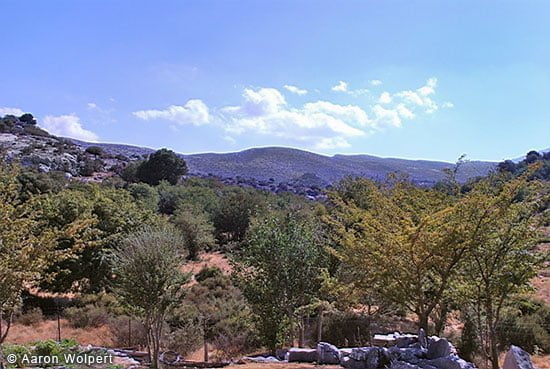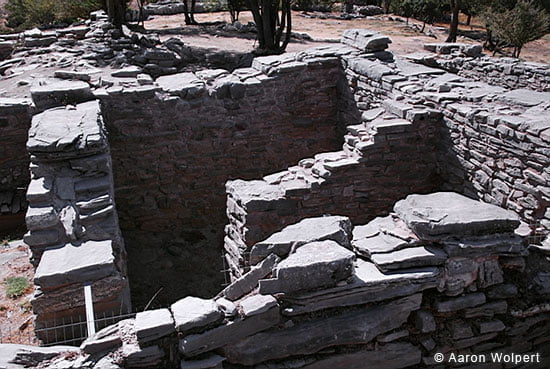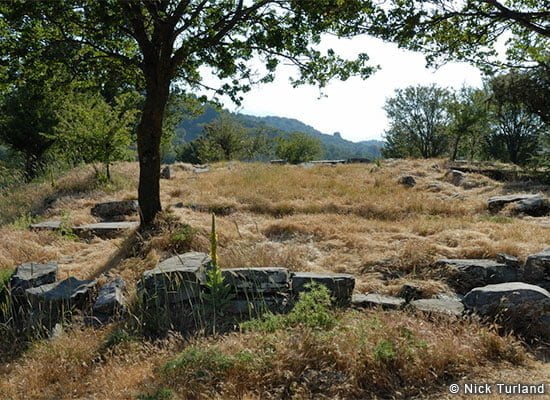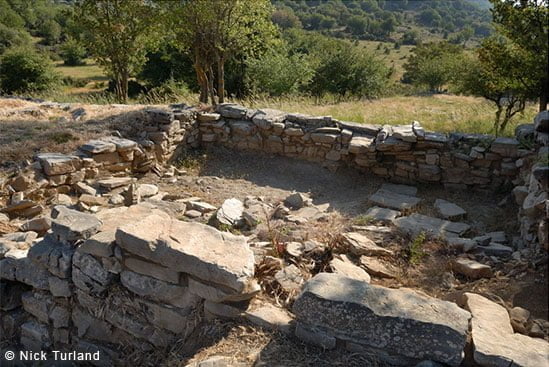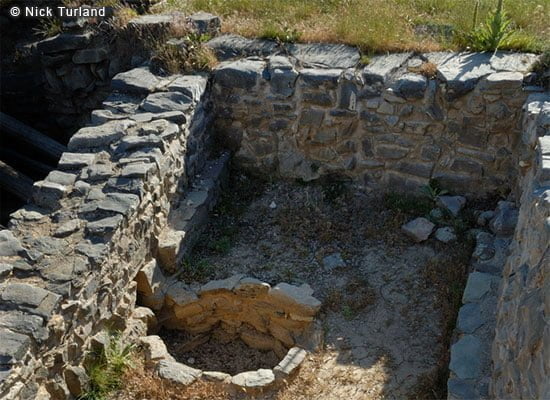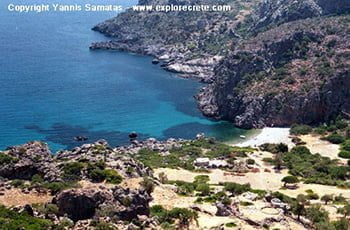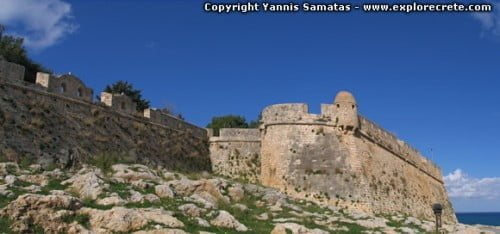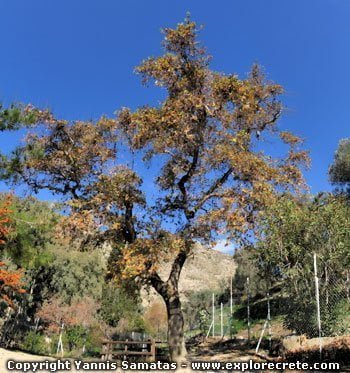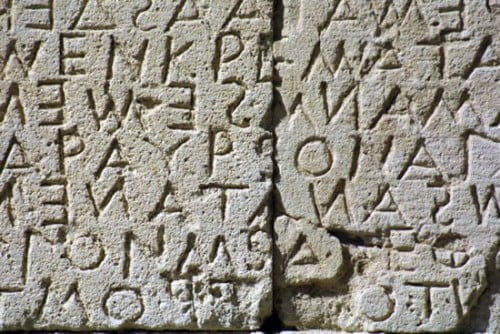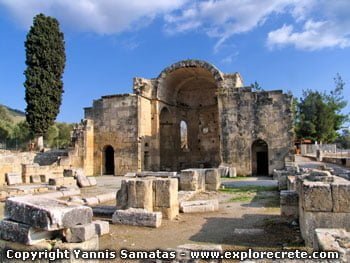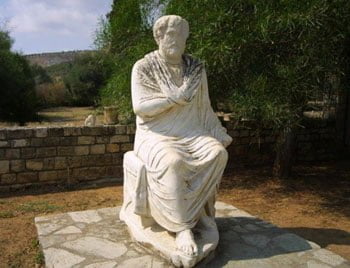The Minoan Town of Zominthos
Zominthos archaeological site
Zominthos is a major archaeological site, a once-flourishing Minoan settlement (1900-1400 BC) on Mount Psiloritis (Mt Ida) in the centre of Crete. It dominates the Zominthos Plateau, at an altitude of 1187 m above sea level and 7,5 km west of Anogia on the road to the Nida Plateau. In Minoan times the sacred road from the Palace of Knossos to the sacred Ideon Cave passed through Zominthos.
Archaeologist Yannis Sakellarakis discovered and excavated Zominthos and the dig is set to continue for many more years, bringing to light important finds which will add greatly to our knowledge of the Minoan civilisation.
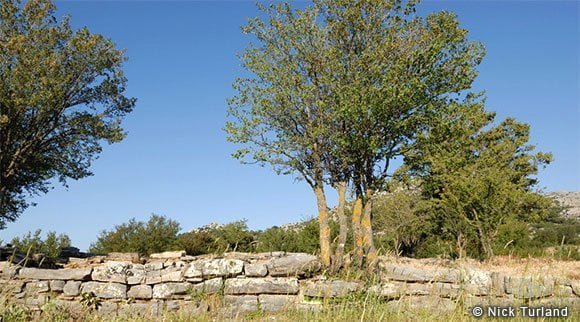
Discovered and excavated by Dr. Yannis Sakellarakis
Zominthos is an important discovery by Dr Yannis Sakellarakis, who was led there, following the unerring instinct of an experienced archaeologist with a long list of digs to his name, when he heard the place-name of Zominthos from a local.

In summer 1982, Archaeology Professor Yannis Sakellarakis with his companion in excavations and in life, Efi Sapouna Sakellaraki, began a systematic excavation at the Ideon Cave, the sacred cave of Psiloritis, a few kilometres from Zominthos.
That was where he first heard the name of Zominthos from a shepherd explaining where he grazed his sheep. The suffix “-inthos” indicates that the name is Prehellenic, and the feisty archaeologist immediately realised that he had made an important discovery.
That same summer (31 August 1982), he visited the area, where his expert eye diagnosed that Zominthos was indeed a place untouched by human hand for the past 1500 years, concealing important information on the distant Minoan past.
The first excavations at Zominthos, though on a small scale, were undertaken by Yannis and Efi Sakellaraki from 1983 to 1990.
In 2004 the excavation began again and continues uninterrupted to this day. The excavation has been included in a five-year study programme under the auspices of the Archaeological Society and the Institute of Classical Archaeology of Heidelberg University, always with the active assistance of Anogia Municipality.
The director of the excavation is Yannis Sakellarakis and his main colleagues are Diamantis Panagiotopoulos, Professor of Prehistoric Archaeology at Heidelberg University, and Honorary Ephor of Antiquities Efi Sapouna Sakellaraki.
The excavation director has studied a work plan using the most up-to-date scientific methods, so that the excavation will be correctly implemented even if it should take many years to complete.
The Zominthos excavation includes scientists from various countries (Greece, Germany, Hungary, Britain), specialising in many areas. Archaeologists, topographers, palaeogeographers, archaeozoologists and archaeobotanists are collaborating in the attempt to study Zominthos, not only from the archaeological point of view, but also as to the environment (flora and fauna) and geographical history of the area. The results of this study will provide us with a full picture of Minoan nature at Zominthos.
UPDATE: Yannis Sakellarakis passed away on 28 October 2010 at the age of 74. Efi Sapouna Sakellaraki continues the excavations until today (2014). Read more about the progress of excavations on https://www.archaeological.org/interactive-dig/zominthos-crete/
Zominthos Pictures
NOTE: The photos from Zominthos are by Nick Turland and Aaron Wolpert, and I want to thank them for their kind permission to use their photos for the purposes of this article.
- photos of Zominthos by Nick Turland
- photos of Minoan Villas by Aaron Wolpert
Finds from the Zominthos excavation
Zominthos is the site of a Neopalatial (c. 1600 BC) building complex with obvious palatial features, of a huge size for its time. This is obviously the administrative centre of the wider area, which was destroyed by a major earthquake along with the surrounding settlement around 1400 BC and never reinhabited.
The central building, with a North-South orientation like that of the palaces, covers an area of approximately 1600 sq. m. and dominated the west hillside, controlling the whole plateau. It has imposing indented façades built of large, dressed blocks of local stone. Its walls, preserved to a height of up to 3m, were faced with clay for insulation and decorated with wall paintings.
This building with many rooms had at least two to three floors, which were destroyed by earthquake (c. 1400 BC), so only the ground floor is visible today.
In the northwest part of the central building was found a workshop with a kiln and more than 150 clay artefacts for everyday use. Many important objects for use and ritual artefacts were also found, made of rare and valuable materials such as rock crystal, which the Minoans believed to have magical properties.
The careful and solid construction of the Zominthos buildings, together with the important excavation finds (traces of wall paintings, delicate painted vessels of precious materials, jewellery and a plethora of other finds), indicate a Minoan polity, i.e. a handicraft, religious and administrative centre of high aesthetic standards, built on a strategic spot for the control of the area, well-organised and fully adapted to the harsh conditions of the Cretan mountains.
It should be noted that the high altitude (approximately 1100 metres), with its winter snows and cold, did not prevent permanent habitation. We can therefore assume that the Minoans of Zominthos had the technology to survive in conditions far harsher than those on the Cretan coast.
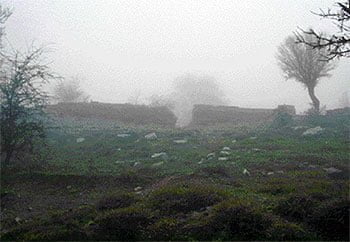
Zominthos is unique in that it is a Minoan town in the mountains, an unexpected discovery since this is the only Minoan settlement in the mountains excavated to date, and indeed such a flourishing one.
Why would a large town be established in the Cretan mountains? Zominthos is on the road to the particularly important sacred Ideon Cave, only a few kilometres distant from it, meaning that the town served both as a way station and as a cult centre.
Zominthos is in an ideal position to control the main roads for the transport of goods to and from the wider area, so it played the role of an economic centre on rich Psiloristis.
At Zominthos the products from the slopes of Psiloritis (farming and animal products and timber) were gathered, to be processed before ending up in other Minoan centres or in the holds of Minoan ships for export.
A good question is how far Zominthos was autonomous or subject to the central control of one of the great palaces, such as that of Knossos (politico-economic control). We do not yet know the answer to this.
Zominthos present and future
The archaeologist Yannis Sakellarakis declared that Zominthos was the dig of his life, a surprising thing to says given that he boasts some of the most important prehistoric excavations in Crete (Archanes, Ideon Cave).
As Yannis Sakellarakis himself said, “Zominthos had the good luck after its destruction to remain as it fell, without its building materials being reused or the area being reinhabited, nor was it desecrated by illegal excavators. Therefore the excavation will bring all its riches to the surface. On the other hand, Zominthos is far from inhabited areas in a completely natural environment which has been preserved since antiquity without human intervention. It provides an opportunity to rebuild, as far as possible, the picture of the Minoan period.”
As for the future, the archaeologist Yannis Sakellarakis and his colleagues had a dream: the creation of an archaeological park on Psiloritis around Zominthos. The antiquities would remain in their natural state in an environment free of human intervention since ancient times, so that visitors could experience the “Minoan serenity”.
© explorecrete.com All Rights Reserved. Reproduction or copying without permission is prohibited.

